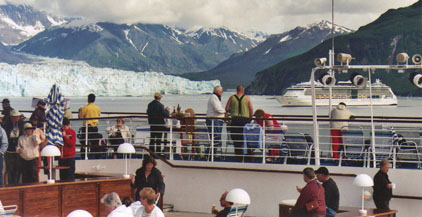Tri-City Herald, Sunday, October 9, 2005
Alaska's Glaciers Retreat, Advance
© 2005 Valerie Kreutzer

The mighty Mendenhall Glacier extends its cascades of ice just 13 miles from downtown Juneau and is a must-see if you visit Alaska’s capital.
Instead of buying $45-$90 glacier tours on our cruise ship, my savvy sister Claudia spotted a shuttle bus on the dock after our arrival; it charged $5 per roundtrip and ran every 30 minutes.
It delivered us shortly to the edge of an iceberg-dotted lake at the foot of the enormous ice field that ends in a glacier. At the nearby visitors center you can learn all about the many glaciers in Alaska’s Southeast where moist air flows towards the mountains and rises to release snow and rain.
As snow accumulates year after year, it compacts the underlying layers. Over time, ice moves and scours rocks from the surrounding valley walls, creating the dark debris lines that give glaciers their dirty look.
And what about the bluish patches, we asked the ranger. They are the result of a trick of light, he explained. Molecules of ice absorb all the colors of the light spectrum, except the blue that it transmits. The blue patches appear where a new wedge of ice has just calved from the field.
The Mendenhall Glacier, he added, has been retreating since the mid-1700s, recently at an alarming rate of 50-100ft per year because of climatic warming trends. “But even at this rate, the glacier would take centuries to completely disappear,” he assured us.
To catch a look from above, the four youngest in our group hiked up the mountain to a waterfall. They returned with a tale of close encounters with a shaggy brown bear and her two cubs. The bear family had passed nonchalantly at less than 10 feet, following their noses to plentiful berries and spawning salmon.
Midway through our cruise we stopped at Hubbard, the longest tidewater glacier in North America. It sits at the head of Disenchantment Bay and extends for six miles. Another cruise ship already anchored there looked dwarfed by the glacier’s massive ice cliffs.
Hubbard was dubbed the ‘galloping glacier’ when it advanced hundreds of feet in the summer of 1986, closing the entrance to a fjord, trapping seals. But within a few months the ice dam ruptured, pouring millions of cubic feet of water per second into the bay. The glacier soon returned to its original position, making scientists wonder whether it might gallop again.
Taking it all in at the railing, we heard rolls of thunder, followed by chunky blocks of ice crashing into the sea in a cloud of spray. Our ship advanced and turned gingerly past icebergs floating all around us.
“Our ship is just a little bigger than the Titanic,” informed my nephew Mark, providing a chilling flashback on an otherwise radiant day.
